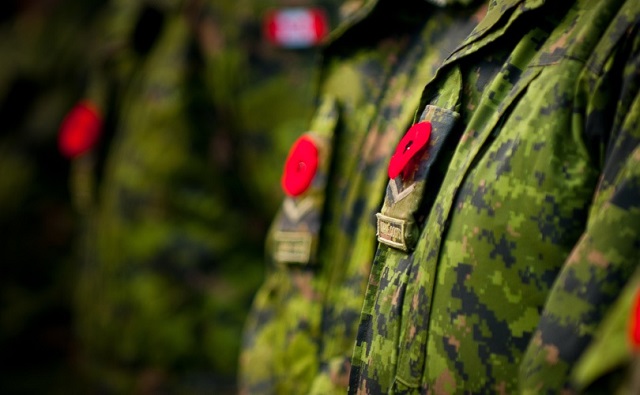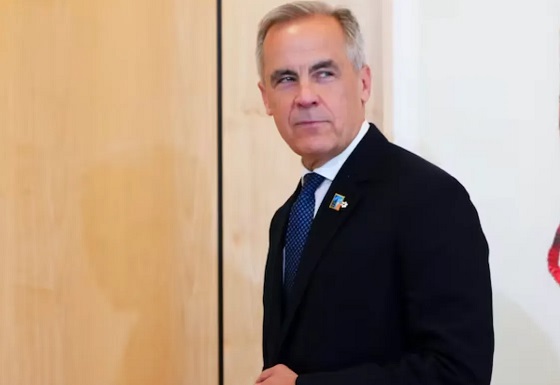armed forces
From Batoche to Kandahar: Canada’s Sacrifices for Peace

From the Frontier Centre for Public Policy
By Gerry Bowler
There is a grave on a riverbank near Batoche, Saskatchewan. It contains the remains of a soldier from Ontario who died in 1885 under General Middleton during the last battle of the Northwest Rebellion. It has been tended for almost 150 years by the Métis families whose ancestors had fought against him. His name was Gunner William Phillips and he was 19 years old.

Up a dirt road in the Boshof District of Free State, South Africa is a memorial garden in which are buried the 34 bodies of Canadians killed at the Battle of Paardeberg in 1900. They fell driving a Boer kommando off the heights where they had been dug in and inflicting severe casualties on the British forces below. Private Zachary Richard Edmond Lewis of the Royal Canadian Regiment lies there. He was the son of Millicent Lewis and was 27 years old.
On April 22, 1915 the German army launched its first poison gas attack on Allied trenches near Ypres, Belgium during the First World War. When French troops on their flanks broke and ran, the 1st Canadian Division stood fast amid the chlorine cloud and repelled their attackers, suffering 2,000 casualties in the process. On the grave of Private Arthur Ernest Williams of the 8th Battalion are the words “Remember, He Who Yields His Life is a Soldier and a Man.” Private Williams was 16 years old.
When the Japanese invaded Hong Kong in December 1941, Canadian troops from the Winnipeg Grenadiers were there to resist them. Among them was Sergeant-Major J.R. Osborn whose men were surrounded and subject to grenade attacks. Osborn caught several of these and flung them back but when one could not be retrieved in time he threw himself on the grenade as it exploded trying to save his men. His body was never found after the battle but his name is inscribed on a monument in Sai Wan Bay War Cemetery.
In the hills south of Algiers is Dely Ibrahim Cemetery. This is where they buried the body of RCAF Pilot Officer John Michael Quinlan after the crash of his Wellington bomber in March, 1944. He was a movie-star handsome student from Prince Albert, Saskatchewan and my father’s best friend in the squadron. I carry his family name as my middle name as does my little grand-daughter.
The Kandahar Cenotaph in the Afghanistan Memorial Hall at National Defence Headquarters in Ottawa honours those Canadians who died fighting Islamic terrorists. 158 stones are bearing the faces of the soldiers who were repatriated from where they fell and now are buried in graves in their home communities across the country. One of those stones commemorates Warrant Officer Gaétan Joseph Francis Maxime Roberge of the Royal 22nd Regiment who is buried in a cemetery in Sudbury. He was 45 when he was killed by a bomb. He left behind a wife, an 11-year-old daughter and twin 6-year-old girls.

On November 11, we pause to remember the 118,000 Canadian men and women who died fighting, among others, Fenian invaders, Islamic jihadis in Sudan, the armies of Kaiser Wilhelm, Benito Mussolini, and Imperial Japan, Nazi SS Panzer regiments, Chinese and North Korean forces, ethnic warlords in the Balkans, and the Taliban. They died in North Atlantic convoys, in French trenches, in primitive field hospitals, on beaches in Normandy, in the air over England, on frozen hills in Korea, in jungle POW camps, on peace-keeping duty in Cyprus, in the Medak Pocket in Croatia, and in the mountain passes of Afghanistan. We also remember the hundreds of thousands more who returned home alive, but mutilated, shattered in body and mind, the families deprived of sons, fathers, and brothers, and the communities who lost teachers, hockey players, volunteers, pastors, nurses, and neighbours.
We remember them because in honouring their memory we honour the values on which Canada was built. They did not die to create a Canadian empire, acquire foreign territory or satisfy some ruler’s grandiosity; they fought and suffered to protect parliamentary democracy, freedom of expression and religion, a tolerant society, and the right to live in peace.
On November 11, let us be clear that the prosperity and tranquility enjoyed today by North Americans, Europeans, South Koreans, Japanese, Indians, Malaysians, Singaporeans, Filipinos, etc., etc., were purchased with the blood of heavily-armed men in military uniform, many of them with maple leaf patches on their shoulders. A country which is contemptuous towards its duty to maintain its armed forces, where schools forbid personnel in service dress from attending remembrance assemblies lest their presence makes children and parents “feel unsafe,” or where Forces chaplains are instructed to avoid religious language or symbols in services commemorating our dead, is a nation lost to its memories and unlikely to have much of a future.
KILLED IN ACTION. BELOVED DAUGHTER OF ANGUS & MARY MAUD MACDONALD,
Nursing Sister Katherine MacDonald, Canadian Army Nursing Service, May 19th 1918
HE WOULD GIVE HIS DINNER TO A HUNGRY DOG AND GO WITHOUT HIMSELF.
Gunner Charles Douglas Moore, Canadian Anti-Aircraft Battery, September 19th 1917
BREAK, DAY OF GOD, SWEET DAY OF PEACE, AND BID THE SHOUT OF WARRIORS CEASE.
Sergeant Wellesley Seymour Taylor, 14th Battalion, May 1st 1916
Gerry Bowler, historian, is a Senior Fellow at the Frontier Centre for Public Policy
armed forces
Mark Carney Thinks He’s Cinderella At The Ball

And we all pay when the dancing ends
How to explain Mark Carney’s obsession with Europe and his lack of attention to Canada’s economy and an actual budget?
Carney’s pirouette through NATO meetings, always in his custom-tailored navy blue power suits, carries the desperate whiff of an insecure, small-town outsider who has made it big but will always yearn for old-money credibility. Canada is too young a country, too dynamic and at times a bit too vulgar to claim equal status with Europe’s formerly magnificent and ancient cultures — now failed under the yoke of globalism.
Hysterical foreign policy, unchecked immigration, burgeoning censorship and massive income disparity have conquered much of the continent that many of us used to admire and were even somewhat intimidated by. But we’ve moved on. And yet Carney seems stuck, seeking approval and direction from modern Europe — a place where, for most countries, the glory days are long gone.
Carney’s irresponsible financial commitment to NATO is a reckless and unnecessary expenditure, given that many Canadians are hurting. But it allowed Carney to pick up another photo of himself glad-handing global elites to whom he just sold out his struggling citizens.
From the Globe and Mail
“Prime Minister Mark Carney has committed Canada to the biggest increase in military spending since the Second World War, part of a NATO pledge designed to address the threat of Russian expansionism and to keep Donald Trump from quitting the Western alliance.
Mr. Carney and the leaders of the 31 other member countries issued a joint statement Wednesday at The Hague saying they would raise defence-related spending to the equivalent of 5 per cent of their gross domestic product by 2035.
NATO Secretary-General Mark Rutte said the commitment means “European allies and Canada will do more of the heavy lifting” and take “greater responsibility for our shared security.”
For Canada, this will require spending an additional $50-billion to $90-billion a year – more than doubling the existing defence budget to between $110-billion and $150-billion by 2035, depending on how much the economy grows. This year Ottawa’s defence-related spending is due to top $62-billion.”
You’ll note that spending money we don’t have in order to keep President Trump happy is hardly an elbows up moment, especially given that the pledge followed Carney’s embarrassing interactions with Trump at the G7. I’m all for diplomacy but sick to my teeth of Carney’s two-faced approach to everything. There is no objective truth to anything our prime minister touches. Watch the first few minutes of the video below.

The portents are bad. This from the Globe:
We are poorer than we think. Canadians running their retirement numbers are shining light in the dark corners of household finances in this country. The sums leave many “anxious, fearful and sad about their finances,” according to a Healthcare of Ontario Pension Plan survey recently reported in these pages.
Fifty-two per cent of us worry a lot about our personal finances. Fifty per cent feel frustrated, 47 per cent feel emotionally drained and 43 per cent feel depressed. There is not one survey indicator to suggest Canadians have made financial progress in 2025 compared with 2024.
The video below is a basic “F”- you to Canadians from a Prime Minister who smirks and roles his eyes when questioned about his inept money management.
He did spill the beans to CNN with this unsettling revelation about the staggering numbers we are talking about:
Signing on to NATO’s new defence spending target could cost the federal treasury up to $150 billion a year, Prime Minister Mark Carney said Tuesday in advance of the Western military alliance’s annual summit.
The prime minister made the comments in an interview with CNN International.
“It is a lot of money,” Carney said.
This guy was a banker?
We are witnessing the political equivalent of a vain woman who blows her entire paycheque to look good for an aspirational event even though she can’t afford food or rent. Yes, she sparkled for a moment, but in reality her domaine is crumbling. All she has left are the photographs of her glittery night. Our Prime Minister is collecting his own album of power-proximity photos he can use to wallpaper over his failures as our economy collapses.
The glass slipper doesn’t fit.
Trish Wood is Critical is a reader-supported publication.
To receive new posts and support my work, consider becoming a free or paid subscriber.
Invite your friends and earn rewards
armed forces
It’s not enough to just make military commitments—we must also execute them

From the Fraser Institute
By Jake Fuss and Grady Munro
To reach 2 per cent of GDP this year, the federal government is committing an additional $9.3 billion towards the military budget. Moreover, to reach 3.5 per cent of GDP by 2035, it’s estimated the government will need to raise yearly spending by an additional $50 billion—effectively doubling the annual defence budget from $62.7 billion to approximately $110 billion.
As part of this year’s NATO summit, Canada and its allies committed to increase annual military spending to reach 5 per cent of gross domestic product (GDP) by 2035. While this commitment—and the government’s recent push to meet the previous spending target of 2 per cent of GDP—are important steps in fulfilling Canada’s obligations to the alliance, there are major challenges the federal government will need to overcome to execute these plans.
Since 2014, members of the North Atlantic Treaty Organization (NATO) have committed to spend at least 2 per cent of GDP (a measure of overall economic output) on national defence. Canada had long-failed to fulfill this commitment, to the ire of our allies, until the Carney government recently announced a $9.3 billion boost to defence spending (up to a total of $62.7 billion) that will get us to 2 per cent of GDP during the 2025/26 fiscal year.
However, just as Canada reached the old target, the goal posts have now moved. As part of the 2025 NATO summit, alliance members (including Canada) committed to reach an increased spending target of 5 per cent of GDP in 10 years. The new target is made up of two components: core military spending equivalent to 3.5 per cent of GDP, and another 1.5 per cent of GDP for other defence-related spending.
National defence is a core function of the federal government and the Carney government deserves credit for prioritizing its NATO commitments given that past governments of different political stripes have failed to do so. Moreover, the government is ensuring that Canada remains in step with its allies in an increasingly dangerous world.
However, there are major challenges that arise once you consider how the government will execute these commitments.
First, both the announcement that Canada will reach 2 per cent of GDP in military spending this fiscal year, and the future commitment to spend up to 3.5 per cent of GDP on defence by 2035, represent major fiscal commitments that Canada’s budget cannot simply absorb in its current state.
To reach 2 per cent of GDP this year, the federal government is committing an additional $9.3 billion towards the military budget. Moreover, to reach 3.5 per cent of GDP by 2035, it’s estimated the government will need to raise yearly spending by an additional $50 billion—effectively doubling the annual defence budget from $62.7 billion to approximately $110 billion. However, based on the last official federal fiscal update, the federal government already plans to run an annual deficit this year—meaning it spends more than it collects in revenue—numbering in the tens of billions, and will continue running large deficits for the foreseeable future.
Given this poor state of finances, the government is left with three main options to fund increased military spending: raise taxes, borrow the money, or cut spending in other areas.
The first two options are non-starters. Canadian families already struggle under a tax burden that sees them spend more on taxes than on food, shelter, and clothing combined. Moreover, raising taxes inhibits economic growth and the prosperity of Canadians by reducing the incentives to work, save, invest, or start a business.
Borrowing the money to fund this new defence spending will put future generations of Canadians in a precarious situation. When governments borrow money and accumulate debt (total federal debt is expected to reach $2.3 trillion in 2025-26), the burden of this debt falls squarely on the backs of Canadians—likely in the form of higher taxes in the future. Put differently, each dollar we borrow today must be paid back by more than a dollar in higher taxes tomorrow.
This leaves cutting spending elsewhere as the best option, but one that requires the government to substantially readjusts its priorities. The federal government devotes considerable spending towards areas that are not within its core responsibilities and which shouldn’t have federal involvement in the first place. For instance, the previous government launched three major initiatives to provide national dental care, national pharmacare and national daycare, despite the fact that all three areas fall squarely under provincial jurisdiction. Instead of continuing to fund federal overreach, the Carney government should divert spending back to the core function of national defence. Further savings can be found by reducing the number of bureaucrats, eliminating corporate welfare, dropping electric vehicle subsidies, and many other mechanisms.
There is a fourth option by which the government could fund increased defence spending, which is to increase the economic growth rate within Canada and enjoy higher overall revenues. The problem is Canada has long-suffered a weak economy that will remain stagnant unless the government fundamentally changes its approach to tax and regulatory policy.
Even if the Carney government is able to successfully adjust spending priorities to account for new military funding, there are further issues that may inhibit money from being spent effectively.
It is a well-documented problem that military spending in Canada is often poorly executed. A series of reports from the auditor general in recent years have highlighted issues with the readiness of Canada’s fighter force, delays in supplying the military with necessary materials (e.g. spare parts, uniforms, or rations), as well as delays in delivering combat and non-combat ships needed to fulfill domestic and international obligations. All three of these cases represent instances in which poor planning and issues with procurement and supply chains) are preventing government funding from translating into timely and effective military outcomes.
The Carney government has recently made major commitments to increase military funding to fulfill Canada’s NATO obligations. While this is a step in the right direction, it’s not enough to simply make the commitments, the government must execute them as well.
-

 Alberta7 hours ago
Alberta7 hours agoAlberta Independence Seekers Take First Step: Citizen Initiative Application Approved, Notice of Initiative Petition Issued
-

 Automotive1 day ago
Automotive1 day agoElectric vehicle sales are falling hard in BC, and it is time to recognize reality.
-

 Automotive1 day ago
Automotive1 day agoPower Struggle: Electric vehicles and reality
-

 Business1 day ago
Business1 day agoTrump on Canada tariff deadline: ‘We can do whatever we want’
-

 Business9 hours ago
Business9 hours agoCanada Caves: Carney ditches digital services tax after criticism from Trump
-

 Crime9 hours ago
Crime9 hours agoSuspected ambush leaves two firefighters dead in Idaho
-

 Brownstone Institute2 days ago
Brownstone Institute2 days agoFDA Exposed: Hundreds of Drugs Approved without Proof They Work
-

 Energy1 day ago
Energy1 day agoChina undermining American energy independence, report says








